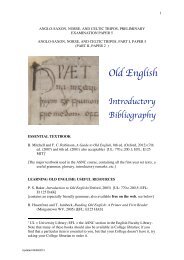Scandinavian history in the Viking age - Department of Anglo-Saxon ...
Scandinavian history in the Viking age - Department of Anglo-Saxon ...
Scandinavian history in the Viking age - Department of Anglo-Saxon ...
Create successful ePaper yourself
Turn your PDF publications into a flip-book with our unique Google optimized e-Paper software.
<strong>Scand<strong>in</strong>avian</strong> History <strong>in</strong> <strong>the</strong> Vik<strong>in</strong>g Age<br />
[B6] The basic scholarly editions <strong>of</strong> <strong>the</strong> Icelandic family sagas, as well as some selected k<strong>in</strong>gs’ saga<br />
material, is <strong>the</strong> Íslenzk fornrit series [ÍF]; <strong>the</strong>se have <strong>in</strong>troductions and notes <strong>in</strong> modern Icelandic and<br />
normalised texts with m<strong>in</strong>imal critical apparatus<br />
[B7] A fur<strong>the</strong>r series <strong>of</strong> <strong>Scand<strong>in</strong>avian</strong> texts was produced by <strong>the</strong> Samfund til udgivelse af gammel nordisk<br />
litteratur [SUGNL]; <strong>the</strong>se old editions have now to some extent been superseded, but cover a wider range<br />
than Íslenzk fornrit<br />
Non-<strong>Scand<strong>in</strong>avian</strong> sources<br />
[B10] The most significant body <strong>of</strong> material relat<strong>in</strong>g to <strong>the</strong> Vik<strong>in</strong>gs can be found <strong>in</strong> <strong>the</strong> huge series<br />
Monumenta Germaniae historica [MGH] which was begun <strong>in</strong> Germany <strong>in</strong> <strong>the</strong> n<strong>in</strong>eteenth century. The<br />
<strong>in</strong>itial series <strong>of</strong> edited texts under <strong>the</strong> head<strong>in</strong>g Scriptores [SS] [UL R560.G101] has now largely been<br />
superseded by <strong>the</strong> Scriptores rerum germanicarum <strong>in</strong> usum scholarum [SRG] [UL 570:01.c.8.1 ff.] and<br />
<strong>the</strong>n <strong>the</strong> Scriptores rerum germanicarum nova series [SRG n.s.] [UL 570:01.c.10.1 ff.]. Large amounts <strong>of</strong><br />
o<strong>the</strong>r relevant material can also be found under <strong>the</strong> auspices <strong>of</strong> MGH; <strong>in</strong> particular, diplomatic material <strong>in</strong><br />
<strong>the</strong> series Diplomata [DD] [UL R560.G118] and correspondence <strong>in</strong> <strong>the</strong> series Epistolae [EPP]<br />
[R560.G111]<br />
[B11] A fur<strong>the</strong>r useful set <strong>of</strong> Frankish or German primary sources can also be found <strong>in</strong> <strong>the</strong> series<br />
Ausgewählte Quellen zur deutschen Geschichte des Mittelalters [AQDGM] [UL 570:01.c.57.1 ff.], which<br />
have <strong>the</strong> advant<strong>age</strong> <strong>of</strong> both Lat<strong>in</strong> texts and German fac<strong>in</strong>g translations<br />
II. NON-SCANDINAVIAN SOURCES<br />
As <strong>the</strong> <strong>Scand<strong>in</strong>avian</strong>s were illiterate (<strong>in</strong> <strong>the</strong> strict sense <strong>of</strong> <strong>the</strong> word, at least) dur<strong>in</strong>g <strong>the</strong> Vik<strong>in</strong>g <strong>age</strong>,<br />
sources from outside Scand<strong>in</strong>avia provide <strong>the</strong> bulk <strong>of</strong> our written material for this period. Unfortunately,<br />
<strong>the</strong>y frequently (and naturally) show a clear tendency to be ei<strong>the</strong>r mis- or ill-<strong>in</strong>formed and prejudiced,<br />
and when comb<strong>in</strong>ed with <strong>the</strong> relative paucity <strong>of</strong> historical evidence relat<strong>in</strong>g to Scand<strong>in</strong>avia itself <strong>the</strong>se<br />
factors render such sources ra<strong>the</strong>r less <strong>in</strong>formative than we might <strong>of</strong>ten wish. The sources ga<strong>the</strong>red here<br />
consist largely <strong>of</strong> histories, chronicles, or hagiography, ie. texts that seem to have been written for <strong>the</strong><br />
purpose <strong>of</strong> preserv<strong>in</strong>g historical <strong>in</strong>formation for posterity; for documentary evidence such as laws or<br />
correspondence, see section (B.VI). For guidance <strong>in</strong> <strong>the</strong> bewilder<strong>in</strong>g field <strong>of</strong> mediaeval source materials,<br />
see:<br />
[B15] Typologie des sources du moyen âge occidental (1972 ff.) [UL R532.6]; a series <strong>of</strong> fascicles<br />
exam<strong>in</strong><strong>in</strong>g various k<strong>in</strong>ds <strong>of</strong> sources for mediaeval European <strong>history</strong>, mostly <strong>in</strong> French and naturally very<br />
general<br />
[B16] R.C. van Caenegem et al., Guide to <strong>the</strong> sources <strong>of</strong> medieval <strong>history</strong>, Europe <strong>in</strong> <strong>the</strong> middle <strong>age</strong>s:<br />
selected studies 2 (1978) [UL R532.11]<br />
Many sources, particularly Insular, are also well worth look<strong>in</strong>g up <strong>in</strong>:<br />
[B17] E.B. Graves, A bibliography <strong>of</strong> English <strong>history</strong> to 1485 (1975) [UL R542.50]<br />
Classical sources<br />
Written sources from before <strong>the</strong> eighth century are largely <strong>of</strong> peripheral <strong>in</strong>terest, and tend to consist <strong>of</strong><br />
little more than cursory descriptions <strong>of</strong> Scand<strong>in</strong>avia and observations on <strong>the</strong> characteristics and<br />
movements <strong>of</strong> <strong>the</strong> tribes resident <strong>in</strong> <strong>the</strong> region. Accord<strong>in</strong>gly, only a small selection <strong>of</strong> <strong>the</strong> vast literature<br />
on <strong>the</strong> subject is given.<br />
[B25] The Classical geographers. The earliest written reports <strong>of</strong> Scand<strong>in</strong>avia come from <strong>the</strong><br />
geographers and philosophers <strong>of</strong> <strong>the</strong> Classical period. Particularly strik<strong>in</strong>g are <strong>the</strong> reports <strong>of</strong> <strong>the</strong> Greek<br />
explorer Py<strong>the</strong>as <strong>of</strong> Marseilles, who is said to have reached a place called ‘Thule’ <strong>in</strong> <strong>the</strong> nor<strong>the</strong>rn oceans<br />
<strong>in</strong> <strong>the</strong> fourth century BC (C10). Py<strong>the</strong>as’ accounts were only preserved, and largely disbelieved, <strong>in</strong> <strong>the</strong><br />
works <strong>of</strong> later authors such as [a] Strabo. Text and transl.: H.L. Jones, The geography <strong>of</strong> Strabo, Loeb<br />
classical library, 8 vols (1917-32) [UL R707.5 STR.1-8]. Fur<strong>the</strong>r details were also provided by <strong>the</strong><br />
Roman scholar [b] Pl<strong>in</strong>y. Text and transl.: H. Rackham et al., Pl<strong>in</strong>y, Natural <strong>history</strong>, Loeb classical<br />
library, 10 vols (1938-62) [UL R712.5 PLI.3-12]. The fullest classical geography, which touches on<br />
‘Scandia’, is that <strong>of</strong> [c] Ptolemy. Text: O. Cuntz, Die Geographie des Ptolemaeus (1923) [UL N.47.48].<br />
7






